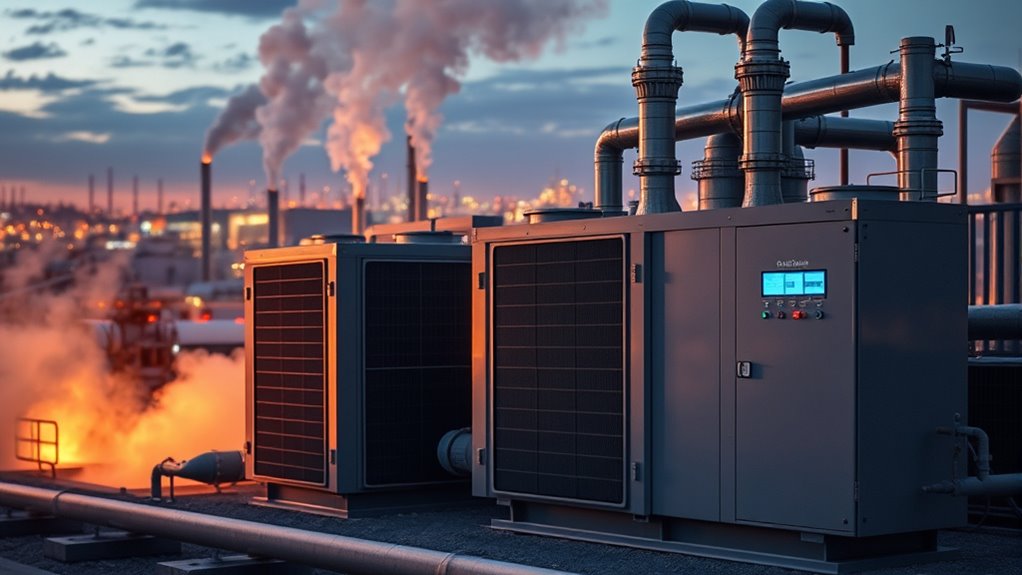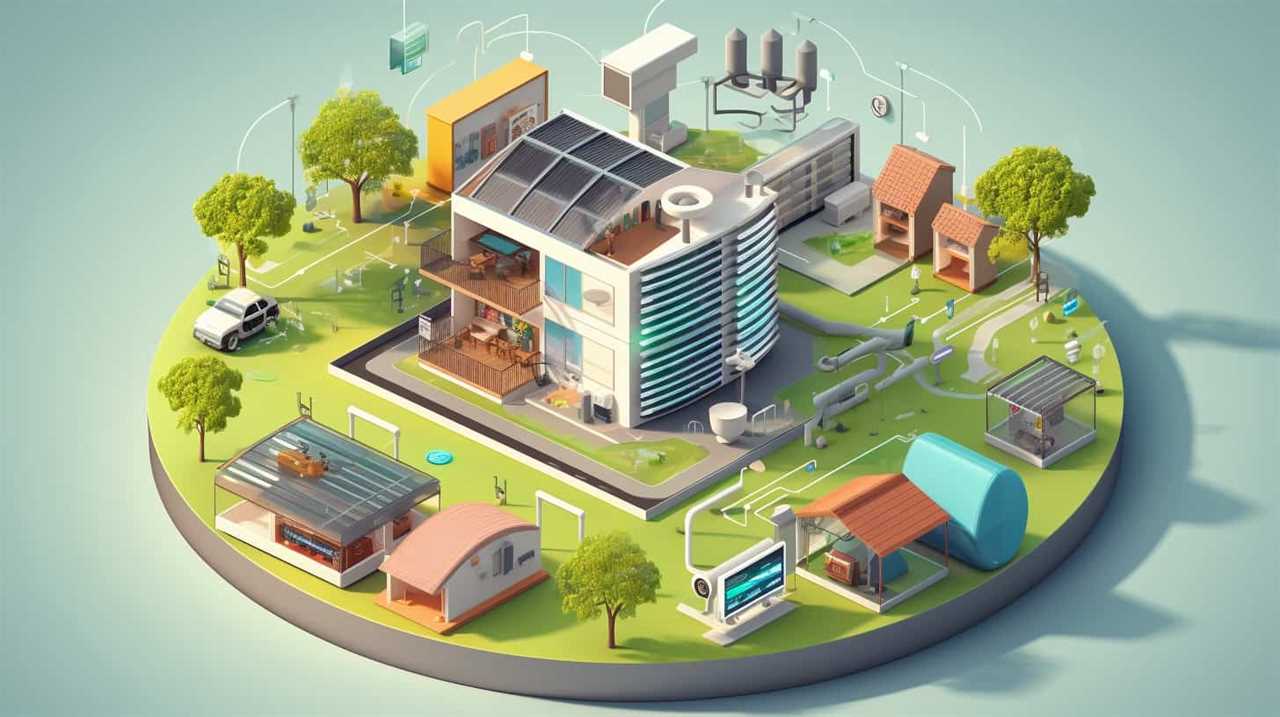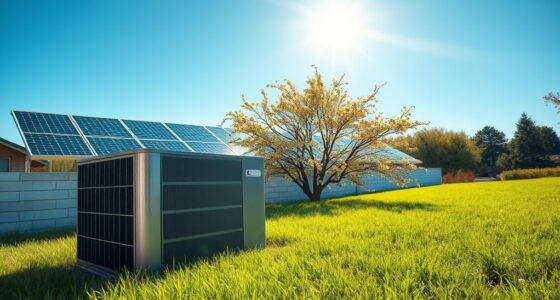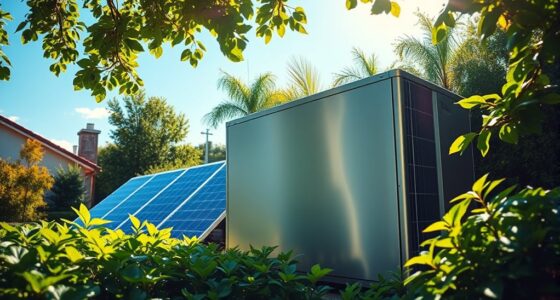Waste heat recovery with heat pumps offers a significant opportunity to improve energy efficiency and cut costs across many industries. By capturing excess heat from processes like refining, cement, and chemicals, you can upgrade lower-grade heat into useful energy or heating, reducing reliance on fossil fuels. Advancements in heat pump technology make it feasible to recover more heat at higher temperatures, boosting sustainability. To understand how these innovations can be practically implemented, keep exploring the latest solutions and strategies.
Key Takeaways
- Waste heat from industries like refining, cement, and chemicals can be effectively recovered using heat pump technology.
- High-temperature heat pumps can convert waste heat above 150°C into useful energy or heat for industrial and district applications.
- Integrating heat pumps enhances energy efficiency, reduces fossil fuel dependence, and lowers greenhouse gas emissions.
- Advances in thermodynamic cycles and nanofluids improve the reliability and cost-effectiveness of waste heat recovery systems.
- Urban waste heat from data centers and buildings offers significant potential when upgraded with heat pumps for district heating.
Understanding Waste Heat Sources Across Industries
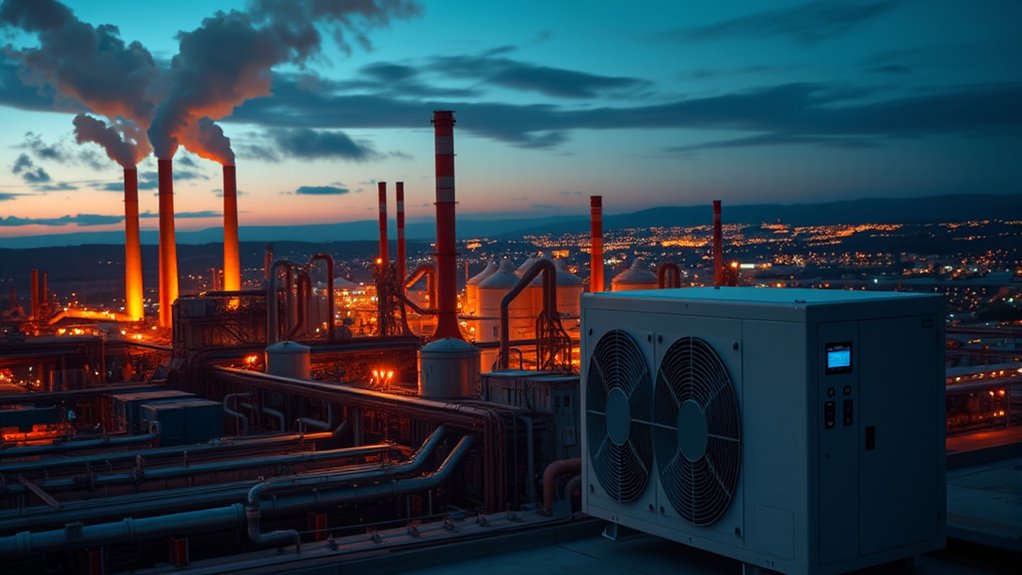
Waste heat sources are found in nearly every industry, often at temperatures between 120°C and 250°C with power duties of 5 to 25 MW. These waste heat sources originate from various industrial processes, such as refining, cement manufacturing, steel production, and chemical processing. By capturing heat from units like VGO hydrotreaters, industries can recover significant energy, reducing waste and costs. The temperature levels of waste heat determine how it can be utilized; medium-temperature heat is suitable for generating steam or electricity, while lower temperatures require advanced solutions like heat pumps. Effective energy recovery depends on understanding these sources, optimizing heat transfer, and integrating suitable technologies to maximize efficiency and sustainability across sectors. Additionally, selecting appropriate heat transfer methods is crucial for maximizing energy recovery efficiency and ensuring the economic viability of heat pump applications. Recognizing the reliability of heat sources helps in designing systems that can operate consistently and deliver optimal performance over time. Moreover, assessing the temperature range of waste heat is essential for choosing the most effective recovery technology and ensuring the system’s overall efficiency. Incorporating innovative heat exchange techniques can further enhance recovery rates and system performance in various industrial settings. Understanding the potential for integration with existing energy systems can also improve overall plant efficiency and reduce operational costs.
Technological Innovations Driving Waste Heat Recovery
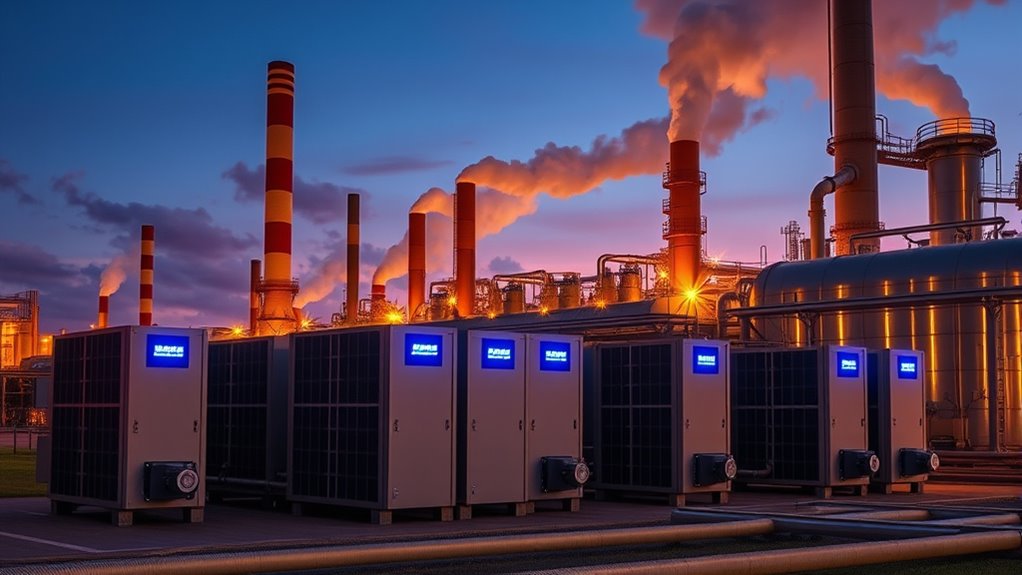
Recent innovations like high-temperature heat pumps and advanced thermodynamic cycles are transforming waste heat recovery. These technologies boost efficiency and make large-scale applications more cost-effective. As a result, industries can better harness low-grade heat, reducing costs and environmental impact. Additionally, integrating renewable energy solutions such as solar and wind power can further enhance overall sustainability and energy efficiency in industrial processes. Incorporating heat pump technology into existing systems can optimize energy utilization and improve overall operational performance. Moreover, understanding zodiac compatibility can inspire innovative approaches to collaborative energy projects by highlighting complementary traits and strengths. Furthermore, advancements in thermal management strategies are essential for maximizing recovery efficiency and ensuring system reliability, especially as industries seek to adopt more sustainable practices.
High-Temperature Heat Pumps
High-temperature heat pumps have revolutionized waste heat recovery by efficiently capturing heat above 150°C from industrial processes such as steel, cement, and chemicals. Recent advancements enable vapor compression heat pumps to reach outlet temperatures up to 200°C, broadening their application in process industries. These innovations rely on optimized compressor technologies and refrigerant cycles, which enhance system reliability and COP at high temperatures. By converting low- to medium-temperature waste heat into useful industrial heat or electricity, they considerably boost energy efficiency. The growing affordability of high-temperature heat pumps, driven by technological improvements and cost reductions, makes waste heat recovery more feasible for industry. Additionally, ongoing research into system efficiencies aims to further improve performance and cost-effectiveness. As the industry progresses, thermal management strategies are being developed to maximize heat recovery effectiveness. Implementing effective heat transfer techniques is crucial for optimizing overall system performance. Furthermore, integrating co-location of industries can enhance waste heat utilization by sharing heat sources and infrastructure. Advances in heat pump components are also contributing to higher operational stability and longevity. This progress supports decarbonization goals and promotes sustainable energy management in process industries.
Advanced Conversion Technologies
Advancements in conversion technologies are transforming how industries harness waste heat, making recovery more efficient and cost-effective. High-temperature heat pumps with advanced compression and absorption cycles now recover heat up to 200°C or higher, boosting energy reuse. Organic Rankine Cycle (ORC) systems, especially when paired with innovative working fluids like nanofluids, convert low-grade waste heat into electricity more effectively. Nano-enhanced working fluids, such as silver/pentane nanofluids, improve thermal conductivity and heat transfer, enhancing system performance. Emerging configurations, including fluidized beds and thermoelectric generators integrated with pulsating heat pipes, further optimize low-temperature waste heat recovery. These advanced conversion technologies, combined with thermal energy storage solutions, enable industries to maximize waste heat recovery and improve overall energy efficiency. Moreover, the development of support services such as technical assistance and maintenance is crucial for maximizing the effectiveness of these systems. Additionally, the integration of vetted electric bike conversion kits demonstrates how innovative energy solutions can be tailored for diverse applications, emphasizing the importance of versatile and reliable technologies in sustainable energy strategies. Incorporating monitoring and control systems can further enhance the performance and longevity of heat recovery systems, especially by utilizing real-time data analysis to optimize operation parameters.
Economic Benefits of Implementing Industrial Heat Pumps
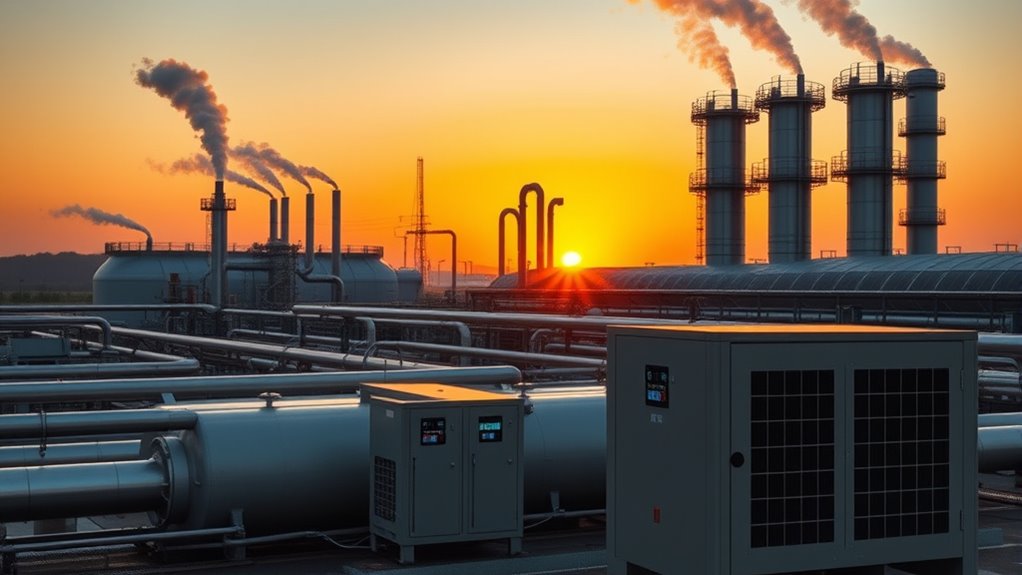
Implementing industrial heat pumps offers compelling economic benefits, primarily by cutting operational costs through substantial energy savings. By utilizing waste heat recovery, you can boost efficiency and reduce reliance on fossil fuels, lowering fuel expenses. The economic benefits are considerable; industries can achieve energy savings of up to 30% in their processes. Additionally, technological advancements and falling costs of heat pump systems make these investments more attractive. Governments also support this shift with policies like tax rebates and low-interest loans. Proper planning and management are essential to maximize these benefits and ensure a successful transition. Utilizing waste heat recovery can further enhance overall process efficiency, making the investment even more advantageous. Incorporating energy-efficient systems like heat pumps not only helps reduce operational costs but also aligns with sustainability goals and reduces environmental impact. Staying updated on technological advancements ensures that industries continue to benefit from the latest innovations in heat pump technology. Moreover, adopting natural techniques for seed production can improve the sustainability and profitability of agricultural processes.
Sector-Specific Opportunities for Waste Heat Utilization
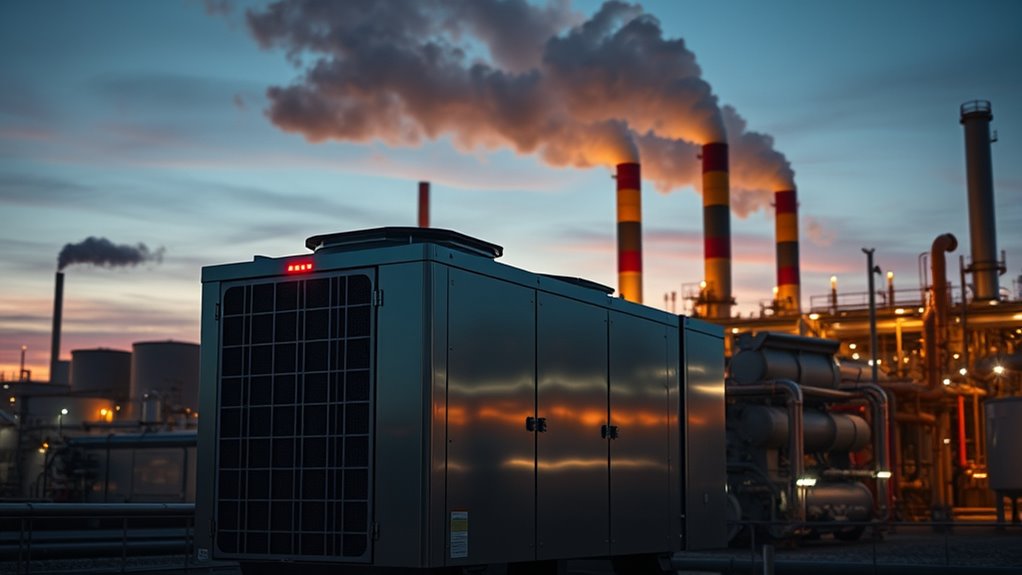
You can target industries like refineries, cement, steel, and chemicals, which produce waste heat between 120°C and 250°C for energy recovery. Urban areas and district heating networks also present opportunities to utilize waste heat at 40°C and above through heat pump integration. By focusing on these sectors, you maximize efficiency and reduce costs while supporting decarbonization efforts. Additionally, understanding the role of attention in optimizing creative problem-solving can inspire innovative approaches to waste heat management and system design. Incorporating AI-powered data analytics can further enhance the identification of optimal waste heat sources and improve system performance. Recognizing the importance of sector-specific strategies ensures tailored solutions that effectively address unique industry needs.
Industry Suitability Factors
Certain industries are particularly well-suited for waste heat recovery using heat pumps, especially those with high-temperature waste streams. These sectors often generate waste heat above 40°C, making them ideal candidates for industrial waste heat recovery. The effectiveness of heat pumps depends on the temperature level and process integration, which determine how well waste heat can be upgraded for reuse.
- Industries like refineries, cement, and chemical plants produce waste heat over 120°C, benefiting from integrated heat pump systems to maximize energy efficiency.
- Sectors such as paper mills and food processing generate continuous, large-scale waste heat, enabling cost-effective recovery solutions.
- High energy prices and process flexibility for heat cascade or reuse at multiple temperature levels further improve economic viability.
Urban and District Use
Have you considered how urban waste heat can be harnessed to improve energy efficiency and reduce emissions? Urban heat recovery involves capturing waste heat from sources like data centers and buildings, then upgrading it with heat pumps for district heating or industrial use. High-temperature heat pumps can turn waste heat into steam, as seen in Spain’s Catalonia project, saving 13,000 MW of thermal energy annually. This approach supports decarbonization by decreasing reliance on fossil fuels in district heating and industrial processes. Large-scale heat pumps enable industries to recover excess heat efficiently, contributing to circular energy systems and lowering greenhouse gases. Policy incentives and infrastructure are essential to expanding these opportunities, integrating low-grade waste heat at temperatures around 40°C or higher for urban heat recovery.
Case Studies Highlighting Successful Heat Pump Applications
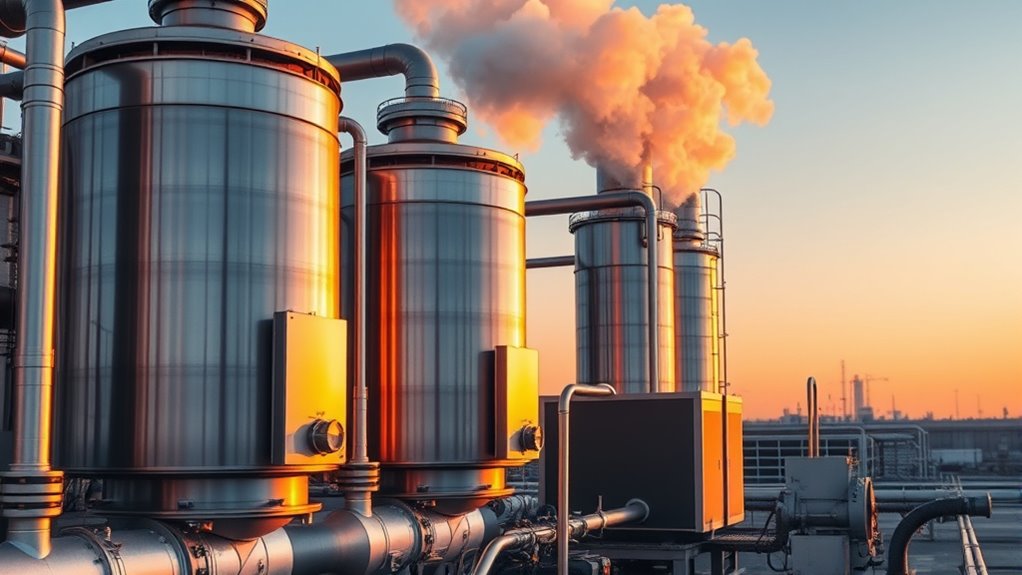
Numerous real-world examples demonstrate how heat pumps effectively recover waste heat and deliver substantial economic and environmental benefits. For instance, the Weissenborn mill in Germany used large-scale high-temperature heat pumps to cut natural gas use by 453,000 m³ annually, reducing CO₂ emissions by 231 tonnes. Similarly, in Catalonia, waste heat from district heating supports a cosmetic factory’s steam needs, saving 13,000 MW of thermal energy each year and cutting emissions by 1,200 tonnes. In the food industry, Mars Inc. adopted GEA heat pump solutions, decreasing operational costs and carbon footprint.
Heat pumps recover waste heat, cutting costs and emissions in industrial applications.
- They optimize waste heat recovery in industrial applications.
- They enable significant energy savings and emission reductions.
- They demonstrate the vast potential for sustainable industrial processes.
Overcoming Challenges in Waste Heat Recovery Deployment
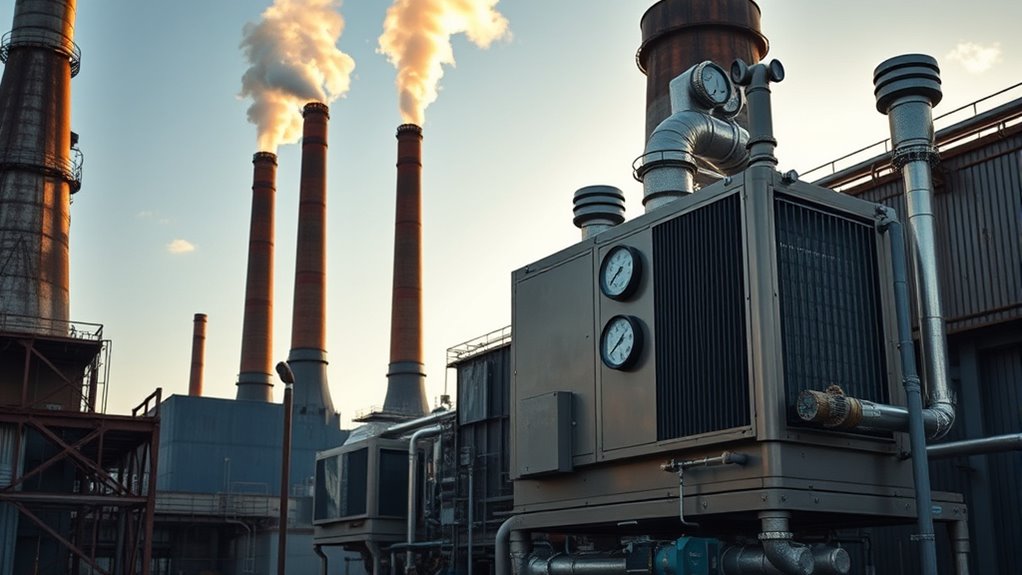
While successful applications showcase the potential of waste heat recovery with heat pumps, deploying these systems faces notable obstacles. Recovering low-temperature heat below 100 °C is tough because of its low exergy content and high heat losses, making efficient capture difficult. Technical barriers, like the need for specialized high-capacity heat pumps that can handle higher temperatures without degradation, limit widespread adoption. Economic constraints also play a role, as low-grade heat recovery often demands significant capital investment with long payback periods. Space limitations in industrial settings can hinder the installation of additional heat exchange equipment. Overcoming these hurdles requires developing advanced materials, innovative system designs, and AI-optimized configurations to boost energy efficiency and make waste heat recovery more feasible and cost-effective.
The Role of Policy and Regulatory Support
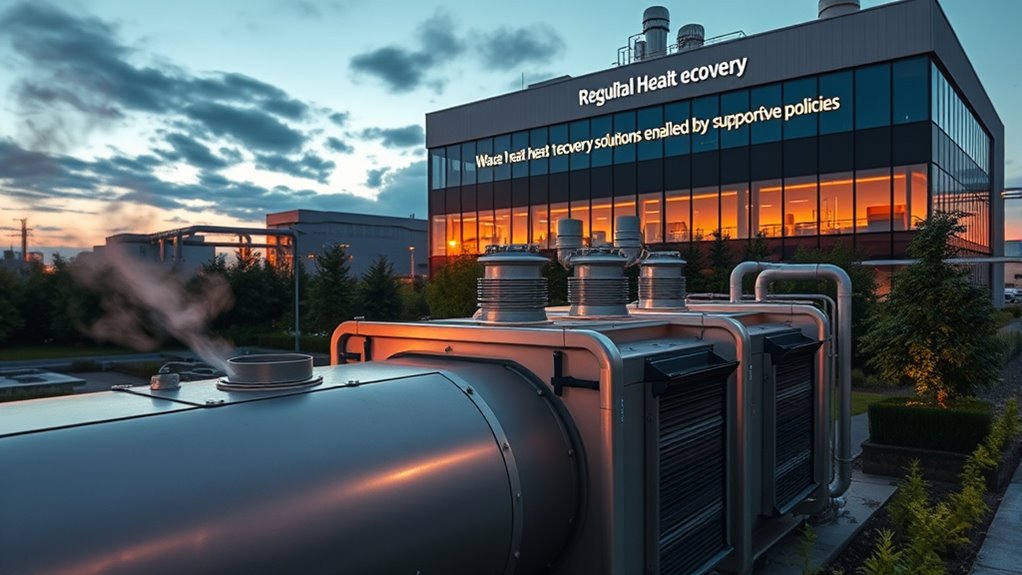
Effective policy and regulatory support are vital for accelerating the adoption of waste heat recovery with heat pumps. You can benefit from policies that expand waste heat recovery definitions to include on-site and district applications, enabling broader deployment across industries and urban systems. Implementing mandatory waste heat reuse plans ensures systematic adoption, while integrating waste heat strategies into the EU’s Renewable Energy Directive and ETS provides key policy incentives for industrial decarbonization. Supportive measures like tax rebates and low-interest loans help lower financial barriers, encouraging investments in heat pumps and infrastructure. Additionally, market mechanisms such as Power Purchase Agreements (PPAs) and targeted financial tools can amplify adoption, aligning waste heat recovery efforts with climate goals. These policies drive faster, more widespread deployment of sustainable heat recovery solutions.
Future Trends and Advancements in Waste Heat Technologies

Recent technological advancements are substantially expanding the capabilities of waste heat recovery systems. High-temperature heat pumps now recover heat up to 200°C, broadening industrial applications. The development of nano-enhanced working fluids boosts thermal conductivity and system efficiency, lowering operational costs by up to 14%. Innovative thermodynamic cycles, like the Organic Rankine Cycle and Kalina cycle, are increasingly integrated with heat pumps to optimize low-grade heat utilization. System advancements, including fluidized beds and AI-optimized controls, improve heat exchange efficiency and responsiveness. Future research aims to develop durable, high-capacity turbo-compressors capable of handling higher temperatures without degradation. These innovations promise to enhance the thermal efficiency and scalability of waste heat recovery technologies, paving the way for more widespread adoption across diverse industries.
Strategies for Maximizing Recovery and Economic Impact
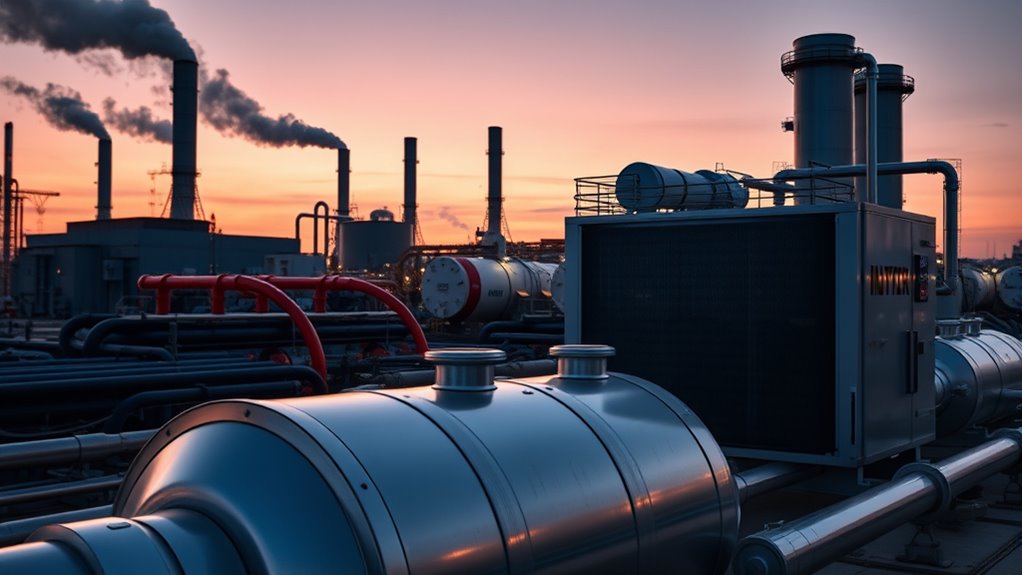
Maximizing the economic and environmental benefits of waste heat recovery requires an all-encompassing approach that extends beyond individual equipment. Focus on site-wide heat integration and process modifications, like adjusting set points or adding reboilers, to boost heat recovery from existing systems. Implementing heat pumps and advanced technologies, such as mechanical vapor recompression, can convert low- and medium-temperature waste heat into useful energy, improving energy efficiency and industrial process heating. To optimize results, consider:
Enhance waste heat recovery through site-wide integration, process tweaks, and advanced technologies like heat pumps and vapor recompression.
- Developing thorough monitoring, evaluation, and employee training programs for continuous improvement.
- Collaborating with industry experts, utility providers, and technology developers to access innovative solutions.
- Scaling up efforts through business models like energy-as-a-service, which support sustained waste heat recovery investments. By adopting these strategies, you can considerably enhance recovery and economic impact.
Frequently Asked Questions
What Is the Recovery Rate of a Heat Pump?
The recovery rate of a heat pump tells you how much waste heat it captures and turns into useful energy. Typically, this rate falls between 70% and 90%, but in industrial setups, it can reach up to 95%. Your system’s efficiency depends on factors like heat source temperature, exchanger quality, and maintenance. To improve it, optimize components and consider advanced tech like nano-enhanced fluids.
What Is a Heat Pump for Waste Heat Recovery?
Imagine capturing the faint glow of lost heat from industrial processes, like collecting sunlight at dawn. A heat pump for waste heat recovery does just that—it extracts low to medium-temperature waste heat and boosts it to higher, useful temperatures. Using thermodynamic cycles, it transfers this heat to heating systems, reducing energy use and emissions, making your industrial operations more efficient and environmentally friendly.
Which Factor Indicates Potential for Waste Heat Recovery?
The key factor indicating waste heat recovery potential is the temperature level of the heat stream, especially above 40°C. You should look at the availability of large, continuous waste heat sources from industrial processes, as well as how close they are to heat demand points like district heating networks. Additionally, verify compatible technology, such as suitable heat pumps, is in place to effectively harness this heat for recovery.
What Is the Major Disadvantage of a Heat Pump System?
Imagine a delicate balance, like a tightrope walker, and that’s your heat pump system. Its major disadvantage is performance drops when temperatures fall below freezing, making it less efficient and increasing energy costs. You also face challenges like high upfront costs, reliance on electricity, and maintenance demands. These factors can hinder its widespread use, especially in colder climates, despite its potential for waste heat recovery.
Conclusion
By embracing waste heat recovery with heat pumps, you harness the potential to revolutionize energy efficiency across industries. This technology isn’t just a small step; it’s a giant leap toward a sustainable future, transforming what was once wasted into valuable power. With innovative solutions and supportive policies, you have the power to turn industrial heat into a renewable resource, making a difference that echoes through generations—truly, it’s a game-changer on an unprecedented scale.
